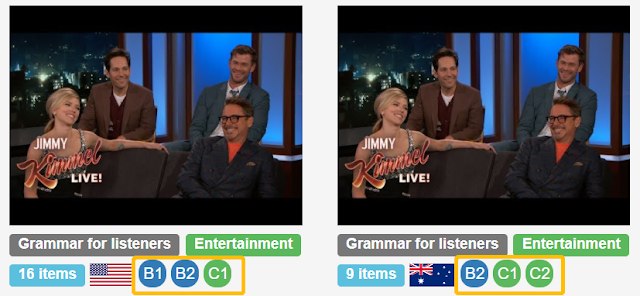If you are really into some 📺 shows or series, I'm sure you will be easily attracted by any quizzes very connected to them. High accuracy gives you a sense of accomplishment and shows you are indeed a huge fan!!!😆
Tube Quizard (link) grasps our mindsets, providing instant quizzes based on various subtitled Youtube videos. Let's take a look!
How to equip with this tool?
This tool is easy for learners and teachers to start with.
📚As a learner:
All you need to look at is the filter. The quiz is selected by its language level, or its type you particularly focus on such as grammar or vocabulary skills. Sorting by category meets various topic demands. Variety filter also satisfies learners with different preferences of different accents.
Here you may notice a different option on whether the context is needed among exercises in the type filter.
I did two tests from 'grammar for listeners' and 'grammar in context' separately and I found that quizzes in 'grammar for listeners' familiarize students with different forms of tense or voice, while exercises in 'grammar in context' require learners to think about why the word or words with specific form is placed in this gap. This judgment depends on the understanding of the context.
💻As a teacher:
You can create your own quizzes in 'Train with your video' page for your students by choosing your favourite video, either search them in 'Search on YouTube' or find the link of those videos and put them into the 'YouTube video URL'.
Alternatively, you can edit the existing quizzes on this platform by clicking the 'edit the quiz' button. Then you will be taken to the 'Search in subtitles' page, where you are able to limit the component of the quiz by time because some videos are long, or remove some words in subtitles by typing them into the blank of 'Find in Youtube subtitles' to create a new gap-fill.
For more guidance, see this video to explore more! 👇👇
The relevance to language learning
Basically, this tool is used to learn grammar as well as vocabulary. More importantly, it fosters learners' listening skills by training their decoding skills.
We often combine top-down and bottom-up approaches to do listening tasks. Decoding skills in this concern is significant in the bottom-up process, especially for learners in lower levels who have limited vocabulary. Besides, the learner who predicts information well but is weak at decoding messages might still fail to make connections between different parts of the text.
How does it foster language learning and promote autonomy?
👍Authentic Materials
Conversations in textbooks are always well-edited. Nonetheless, do dialogues run as smoothly as they are? Do real-life talk straightforward too? I guess not. Therefore, it is good for students to prepare listening skills for real-world communication by exposing themselves to videos in a different real-life context such as interviews.
👍Motivation
In the case that learners can find their favourite topics directly from YouTube beyond TubeQuizard videos to practice listening, they will be especially motivated because people enjoy doing everything within the area that they are interested in. 💗
👍Clear Goal
For each exercise, there's a clear instruction on the top of the page, which enable learners to listen with purpose, so as to repeatedly recognize certain grammar or phrase pronunciation to improve decoding skill.
👍Level Consideration
Do you always worry about whether authentic materials would be too hard for you? No worries! That's why they design a filter to categorize quizzes by their level. Being able to choose the suitable level to practice decoding can somehow strengthen their motivation and autonomy.
Limitation
😱Authentic Materials
Authentic materials may possibly constrain learners on the contrary because of
1. Limited Adaptation
The quizzes are created based on the video without any adjustment such as replacing a difficult word with the one within learners' vocabulary. As said before, decoding skills are particularly necessary for lower-level learners. However, does this website really fit them? Does decoding skill practice requires the use of authentic materials at the very beginning? Whether it would be better to access authentic material as students learn more vocabulary?
2. Lack of Label
I often find exercise by my level, but when I searched for quizzes from videos out of the Tube Quizard homepage, I discovered those videos do not have labels showing difficulty. The same thing happens with self-created quizzes, which to some extent risk reduction of autonomy and motivation.
3. Inaccurate Subtitles
Since subtitles are generated by voice recognition, it is possible that what the speaker says is unclear or with some accents do not actually match the subtitles. This may affect decoding practice because learners take subtitles as the correct answers, but they couldn't confirm that the pronunciation they perceive matches the correct word in this regard.











Hi Cuilin, glad to read a review of the tool that I've explored! It's intriguing that you've explained the tool from both of teachers and learner' sides. Also, you've thought of labels as well. Now that you mentioned it, I can see it'd be better for the team to increase the number of labels so users can narrow down their learning goals. Thank you for the good insight!
ReplyDeleteHi Cuilin! I like your post title! It is catchy! Your post is so organized and nice! I enjoy your blog!
ReplyDeleteHi Cuilin, this is a really nice blog post about Tube Quizard, I like how you have laid out the information and relating it to the particular skills is a really good touch. Also excellent use of emoji :)
ReplyDelete